

Mobile Learning y Realidad Aumentada en Educación. Mi portafolio digital mLearning y RA en Pinterest. Applications of Augmented Reality in Education. 7 Outstanding Augmented Reality Apps for iPad. Teachers' Guide to Augmented reality. Augmented Reality is a concept that has been around for sometime now but with the latest innovations in the digital world, augmented reality has been foregrounded posing serious questions as to its relevancy in education and learning.

What is Augmented Reality ? Augmented Reality is exactly what the name implies: an augmented version of realty created by mixing technology with the known world. It might be a distorted, augmented, or less augmented version of the actual world but in its basic form, augmented reality is a simulation or rather a way of superimposing digital contents into the real context. Augmented reality has its origins as early as the 1950s and has progressed with virtual reality since then, but its most significant advance have been since the mid 1990s when researcher Tom Caudell coined the term "augmented reality," Applications of Augmented Reality in Education. Augmented Reality Brings New Dimensions to Learning. Editor's Note: Drew Minock, who co-wrote this piece, is an elementary teacher, co-founder of the popular education blog Two Guys and Some IPads, and is one of the voices on "The Two Guys Show" podcast.
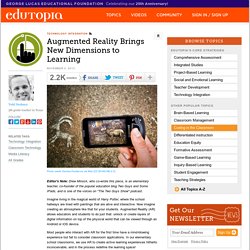
Imagine living in the magical world of Harry Potter, where the school hallways are lined with paintings that are alive and interactive. Now imagine creating an atmosphere like that for your students. Augmented Reality (AR) allows educators and students to do just that: unlock or create layers of digital information on top of the physical world that can be viewed through an Android or iOS device. Most people who interact with AR for the first time have a mind-blowing experience but fail to consider classroom applications.
In our elementary school classrooms, we use AR to create active learning experiences hitherto inconceivable, and in the process redefine the learning space! Classroom Applications Not Just Another Fad There are endless ideas and possibilities for using AR. Augmented Reality. Realidad aumentada. iPad y aprendizaje con realidad aumentada En un post anterior (diciembre de 2011) dedicado a analizar las aportaciones del Informe Horizon 2011,comentamos que la Realidad Aumentada (RA) sería una de las tecnologías que en un par de años se implementarían.
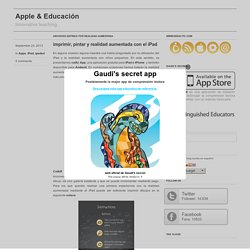
A lo largo de estos meses, hemos tratado la realidad aumentada en diversos ocasiones, destacando: el post dedicado al proyecto T (ether) del Tangible Media Group del MIT Media Lab y el post a la ya popular aplicación gratuita para iOS, Layar. En el 2010 participé en un estudió títulado Innvation in higher education with Sloodle. Por todos es conocido que Sloodle, y su integración intrínseca con Second Life forman parte del mundo virtual. Augmented Reality. Mobile Learning y RA. Aurasma y... ¡Aumenta el mundo! Hace casi un año publiqué en este mismo blog un post titulado "Realidad Aumentada (RA) para todos los públicos".
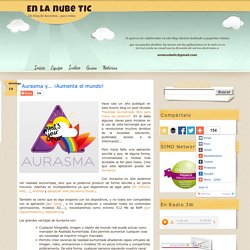
En él daba algunas claves para iniciarse en el uso de esta tecnología que va a revolucionar muchos ámbitos de la sociedad: educación, publicidad, acceso a la información... Pero hacía falta una aplicación sencilla y que, de alguna forma, universalizase e hiciese más accesible la RA para todos. Creo que esta aplicación puede ser Aurasma.
También es cierto que es algo exigente con los dispositivos, y no todos son compatibles con la aplicación (ver lista) , o no todos producen o visualizan todos los contenidos (animaciones, modelos 3D,...); necesitaremos como mínimo 512 Mb de RAM (ver requerimientos y dispositivos). La taxonomie de BLOOM. La classification des objectifs en catégories est ce que l'on appelle la « Taxonomie des objectifs ».
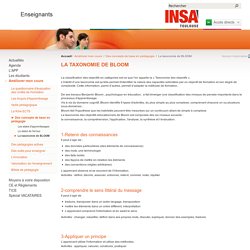
L'intérêt d’une taxonomie est qu'elle permet d'identifier la nature des capacités sollicitées par un objectif de formation et son degré de complexité. Cette information, parmi d’autres, permet d’adapter la méthode de formation. De ses travaux Benjamin Bloom , psychologue en éducation, a fait émerger une classification des niveaux de pensée importants dans le processus d'apprentissage. Vis à vis du domaine cognitif, Bloom identifie 6 types d'activités, du plus simple au plus complexe, comprenant chacune un ou plusieurs sous-domaines : Bloom fait l'hypothèse que les habiletés peuvent être mesurées sur un continuum allant de simple à complexe.
La taxonomie des objectifs éducationnels de Bloom est composée des six niveaux suivants : la connaissance, la compréhension, l'application, l'analyse, la synthèse et l’évaluation. 1-Retenir des connaissances. Définir des objectifs pédagogiques efficaces et cohérents grâce à la taxonomie de Bloom et la méthode SMART.
Une fois les besoins et attentes de formation analysés, définir vos objectifs pédagogiques constitue une étape fondamentale dans le développement de votre projet de formation.
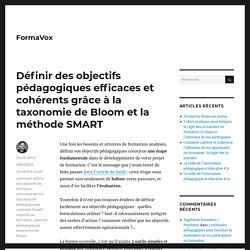
C’est le message que j’avais tenté de faire passer dans l’article de lundi : cette étape vous permet non seulement de baliser votre parcours, et aussi d’en faciliter l’évaluation. Toutefois il n’est pas toujours évident de définir facilement ses objectifs pédagogiques : quelles formulations utiliser ? Faut-il nécessairement intégrer des verbes d’action ?